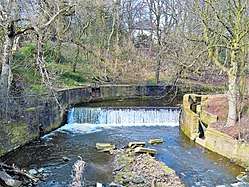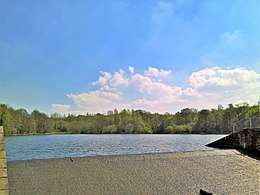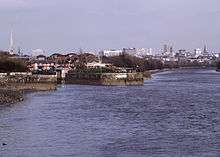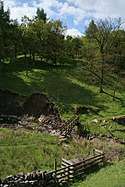River Brun
The River Brun is a river in eastern Lancashire. It is approximately 4.5 miles (7.2 km) long and has a catchment area (not including the River Don) of 9.32 square miles (24.134 km2).[lower-alpha 1][1][2]
| River Brun | |
|---|---|
 The Brun as it falls over the old weir in Burnley | |
| Location | |
| Country | England |
| Physical characteristics | |
| Source | |
| • location | Hurstwood, Worsthorne, Lancashire |
| Mouth | |
• location | River Calder, Burnley |
| Length | 4.5 miles (7.2 km) |

Course
Thought to begin at the confluence of Hurstwood Brook (draining Wether Edge, Hameldon and supplying the Hurstwood Reservoir) and Rock Water at Foxstones Bridge near the village of Hurstwood, the river runs northwest towards the town of Burnley. Rock Water only begins a sort distance to the southeast, where Cant Clough Beck (from that reservoir) meets Shedden Clough.[3]
Heading northwest, the river passes Omerod, the Hollins, the hamlet of Brownside and through the Rowley Lake near Rowley Hall before collecting Swinden Water and then the River Don at Netherwood Bridge and turning west. Entering Burnley at Heasandford, the Brun passes Burnley Youth Theatre, turning southwest and travelling on through Bank Hall Park and under the Leeds and Liverpool Canal into Thompson Park (where it supplies the boating lake) and on past St Peter's Church. As it moves through the town centre it is briefly culverted at the St Peter's Centre and again as it passes under the Charter Walk shopping centre. Having turning back toward the west, the Brun falls over one final weir as it joins the River Calder close to the roundabout on Active Way.[3][4]
History
The river is generally thought to have given its name to Burnley (from the Old English brūn lēah), with the name thought to mean the meadow or clearing by the brown river. However it is impossible to be certain that the town is not named after the brown meadow and river renamed after the settlement achieved some significance.[4][5]
West of Hurstwood the Brun flows under Salterford Bridge, the site of a ford on an ancient saltway.[4] At the end of the Don are the remains of sluices and dams that supply water to the mill lodge for the old Heasandford Mill, historically located further downstream near the old manor house (thought to be anciently the pheasant ford).[5][4][6] Close to St. Peter's the remains of a weir can still be seen, the water went through a goit (part of which has been preserved) to a lodge for the town's old corn mill located next to the Bridge Inn. The mill is thought to have been originally erected around 1290 and was still water-powered until 1820.[4][7] The ancient bridge near the church was demolished in June 1736 and a new one 4 yards wide, with a 16-yard arch was erected nearby. The last crossing before the confluence with the Calder is called Salford,[lower-alpha 2] the area of the town that developed around it was also known by that name in the early 20th century.[9]
The lake at Rowley and the Brun's course onward to Heasandford is an artificial creation of the 1970s. Previously this section of the river flowed further to the west, with the Don collecting Swinden Water before meeting the Brun close to the mill lodge. Bank Hall was formerly the site of a significant coal mine that operated for over 100 years up to 1971,[10] with another near Rowley Hall that operated between 1861 and 1928, and the area was used as a spoil tip for generations. The mine workings caused significant levels of pollution in the river and the diversion scheme also allowed the valley of the old route to be used as a landfill site.[4][11][12]
Restoration works led by Lancashire County Council for over 40-years, has seen the Bank Hall site turned into a park and also the ongoing creation of the Brun Valley Forest Park along the river between Brownside and Heasandford.[12] This was helped by the 2011-15 Urban River Enhancement Scheme (URES) which made improvements the river habitat in the town, including constructing fish passes on the weirs.[13]
References
| Wikimedia Commons has media related to River Brun. |
Notes
Citations
- "Brun - conf Don to conf Calder". Catchment Data Explorer. Environment Agency. Retrieved 12 November 2017.
- "Brun - headwaters to conf Don". Catchment Data Explorer. Environment Agency. Retrieved 12 November 2017.
- "103" (Map). Blackburn & Burnley (C2 ed.). 1:50,000. Landranger. Ordnance Survey. 2006. ISBN 978-0-319-22829-6.
- Jack Nadin (25 April 2003). "On the trail of the elusive River Brun". Burnley Express. Retrieved 15 June 2017.
- Ekwall, Eilert (1922). The place-names of Lancashire. Manchester University Press. p. 83. OCLC 82106091.
- Historic England. "Heasandford House, Heasandford Cottage and Heasandford Lodge, Burnley (1245019)". National Heritage List for England. Retrieved 18 November 2017.
- Historic England. "The Goit, Burnley (1022623)". National Heritage List for England. Retrieved 18 November 2017.
- Ekwall, p. 32.
- Farrer, William; Brownbill, John, eds. (1911), The Victoria History of the County of Lancaster Vol 6, Victoria County History - Constable & Co, pp. 441–454, OCLC 270761418, retrieved 8 December 2017
- "Bank Hall Colliery". Mines Database. Northern Mine Research Society. Retrieved 12 November 2017.
- Frost, Roger; Thompson, Ian; Dewhurst, Victoria (2014), River Calder, Amberley Publishing, ISBN 9781445618920
- Roger Frost (16 June 2015). "Celebrating the history of Burnley's parks". Clitheroe Advertiser. Retrieved 9 December 2017.
- Chris Gee (14 January 2012). "Burnley polluted river clean up hailed as 'remarkable transformation'". Lancashire Telegraph. Retrieved 9 December 2017.
| Next confluence upstream | River Calder | Next confluence downstream |
| - | River Brun | Pendle Water (North) |

